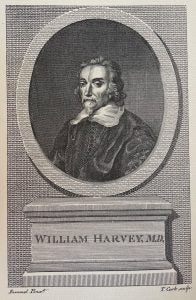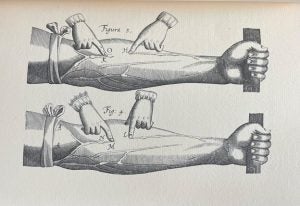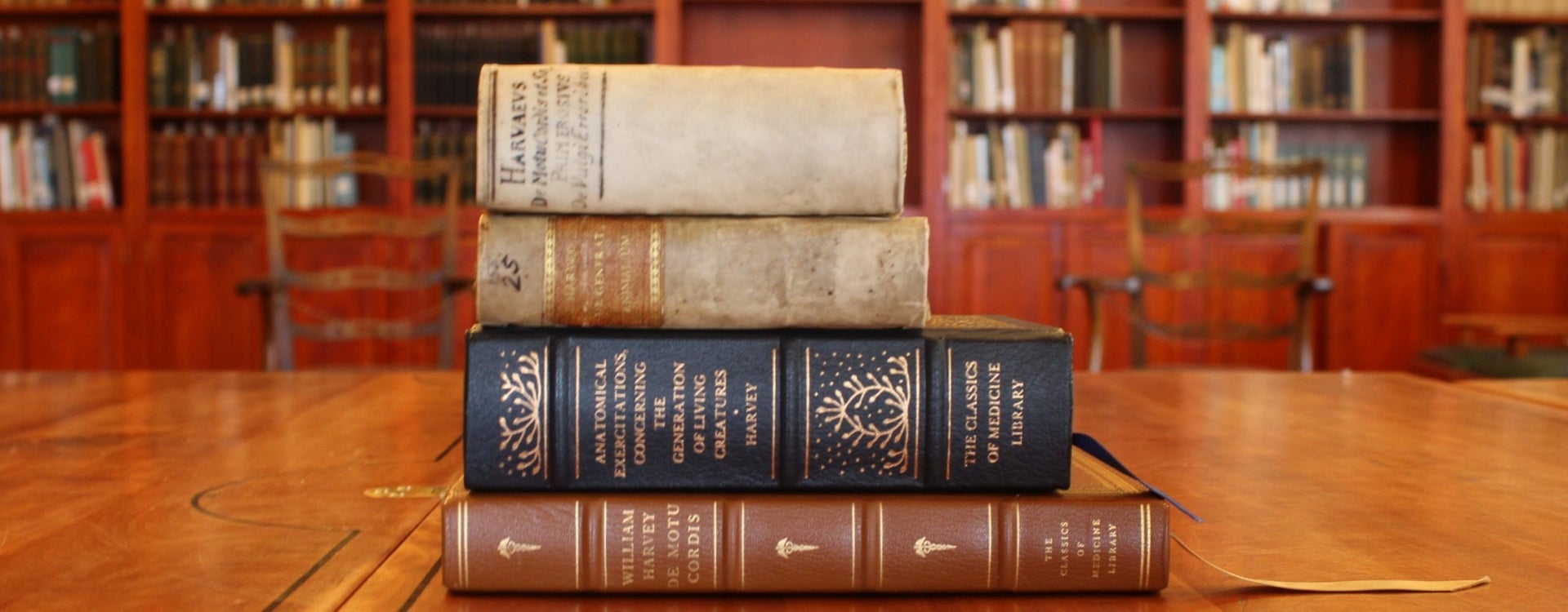Collection Highlight: William Harvey’s Trailblazing Medical Studies
Contributed by Abby Brown, History Collections Graduate Student Assistant

William Harvey in De Motu Cordis.
Recently, Laupus Library’s History Collections acquired a copy of an important work in medical history. William Harvey’s study of eggs in animals was groundbreaking and shaped our understanding of reproduction for centuries. But this is not the only book of Harvey’s in our collection. We also hold his revolutionary study of the circulation system, another game changer in the medical world that was gifted to the library nearly 25 years ago. Read on for more information about Harvey himself and his medical studies.
William Harvey was born in Folkestone, England on April 1st, 1587. Harvey knew he would be a doctor from a young age, starting medical school at Cambridge when he was only 15, then continuing to the University of Padua in Italy where he earned his Doctor of Medicine degree in 1602. That same year he returned to England and was given another Doctor of Medicine degree from the University of Cambridge. While he was a practicing physician at St. Bartholomew’s Hospital in London, he was also a trusted doctor to the monarchy in England. He served both King James I and the heir to the throne, Charles I[1].
Laupus Library at East Carolina University’s Health Sciences Campus currently has two of his works in their collection. Harvey often hesitated to publish his findings due to the drastic changes in medicine that his research proposed. Both of his works featured here made a tremendous impact on the future of medicine and challenged widely accepted beliefs at the time.
His most influential work, De Motu Cordis, published in 1644, translates to English as “The Motion of the Heart,” but the official full English title is Anatomical Studies on the Motion of the Heart and Blood in Animals [2]. This book explains his discovery of the circulation of blood throughout the entire body. He performed experiments on many different living and deceased animals and humans to track how much blood was in the body, how fast it was moving, and where it traveled. Prior to Harvey’s discovery, most of the western world believed the Galen theory–that blood moved as a part of the respiratory system–meaning that blood moved only from the heart to the lungs and back. Another popular theory prior to Harvey posited that there were two different circulatory systems. Harvey used several replicable experiments and diagrams to prove that it was the heart–not the lungs– moving the blood through the body, and that only one circulation system existed in the human body[3]. His primary evidence came from the valves in the heart that pump the blood continuously in one direction, while also stopping the blood from moving backwards. The library has an original copy of De Motu Cordis in Latin, as well as an English translated copy.

Drawing demonstrating Harvey’s findings in De Motu Cordis.
Laupus Library also recently acquired Exercitationes de Generatione Animalium, quibus accedunt quaedam De Partu: de Membranis ac humoribus Uteri: & de Conception [4], published in 1651, in its collection. The English translation for this work is Anatomical Exercitations Concerning the Generation of Living Creatures. This book focuses on obstetrics, and how a fetus forms in the uterus[5]. Prior to Harvey’s work on this topic, it was believed that fetus cells were fully formed humans and that development in the uterus was the human form getting larger. However, Harvey explained in his 72-chapter book how fetal cells gradually increase, creating more parts of the human body. Harvey’s main focus and experiment was on a baby chick. His research followed how a chick develops more and more each day. He did experiments on other animals as well, and declared that all animals and humans, came from an egg[6].
By the time William Harvey died in London on June 3, 1657, he had made extreme advances to the field of medicine that have proven to still be true today. His foundation for the circulatory system led to the discovery of oxygen in the blood, explaining the change in color from red to purple throughout the body. His work on embryology and obstetrics challenged and corrected the ideas of his predecessors and the people who educated him.

Laupus’ holdings of the original and translated copies of William Harvey’s works.
An English translation of both of these books, as well as a first edition of De Motu Cordis from 1639 can be found on the fourth floor of Laupus Library at East Carolina University in the historical collections reading room. Please follow this link to set up an appointment.
[1] MacLean, Robert. 2007. De Motu Cordis. Glasgow, Scotland, June.
[2] Harvey, William. 1639. De Motu Cordis. London, England: Johann Marie, Leiden.
[3] Museum, Mutter. n.d. De Muto Cordis: Our Hearts Beat for Harvey Philadelphia, Pennsylvania.
[4] Harvey, William. 1651. Exercitationes de Generatione Animalium, quibus accedunt quaedam De Partu: de Membranis ac humoribus Uteri: & de Conceptione. London, England: Du-Gardianis.
[5] Morton, Leslie T. 1970. A Medica; Bibliography (Garrison and Morton). Philadelphica and Toronto: J. B. Lippincott Company.
[6] Books, PrPh. n.d. Exercitationes de generatione animalium. Quibus accedunt quaedam de partu: de membranis ac humoribus uteri: and de conceptione. New York, New York.
